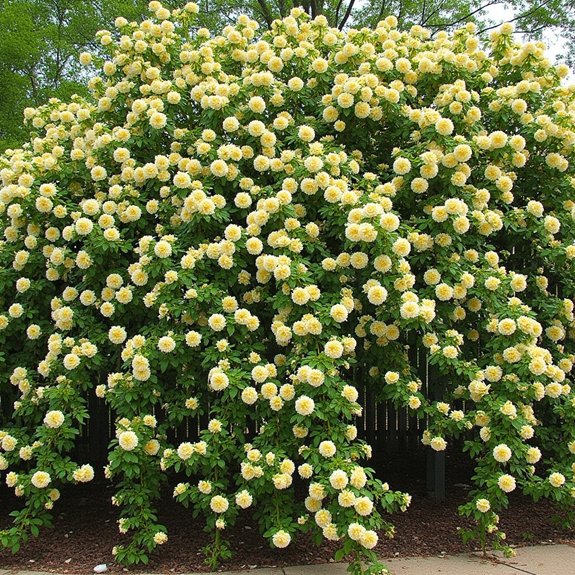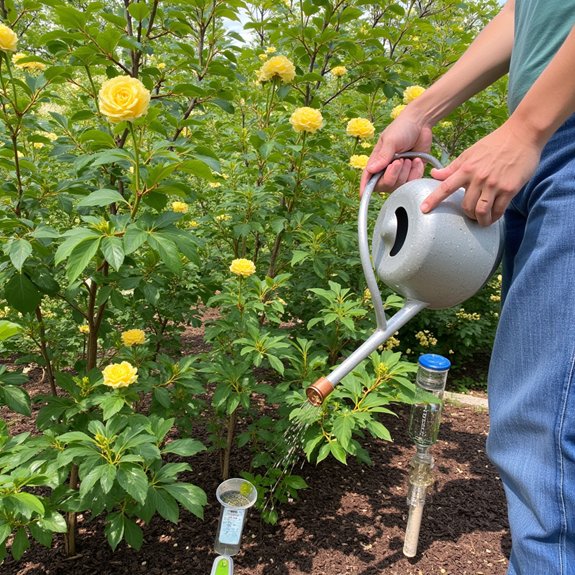Lady Banks roses are like botanical royalty that’ll transform your garden into a flowering palace, but they demand respect for their specific needs. You can’t just plant these vigorous climbers anywhere and expect success – they require strategic placement, precise timing, and understanding of their unique growth patterns. With proper techniques, you’ll reveal their potential for producing thousands of blooms, yet one critical mistake during their post-flowering period could sabotage next year’s spectacular display.
Contents
- 1 Understanding Lady Banks Rose Characteristics and Growing Requirements
- 2 Optimal Planting Locations and Soil Preparation
- 3 Establishing Proper Watering and Fertilization Schedules
- 4 Pruning Techniques for Maximum Bloom Production
- 5 Pest and Disease Prevention Strategies
- 6 Supporting Growth With Structural Training Methods
- 7 Variety Selection and Seasonal Care Management
Understanding Lady Banks Rose Characteristics and Growing Requirements

When you’re considering Lady Banks Rose for your garden, you’ll need to understand this vigorous climber’s impressive scale and unique blooming pattern. This powerhouse reaches 20-50 feet in both height and width, requiring substantial space to flourish properly. The growth habits include nearly thornless canes and glossy green foliage that creates dense coverage. You’ll witness spectacular flower characteristics during its single annual bloom, producing up to 50,000 flowers over 3-5 weeks in spring. It’s drought-tolerant, pest-resistant, and thrives on minimal care. However, don’t attempt container growing—this rose demands 10-20 feet of horizontal space to reach its full potential.
Optimal Planting Locations and Soil Preparation
Since Lady Banks Rose demands considerable space and specific conditions, you’ll need to choose your planting location with careful consideration of both sun exposure and soil drainage. Select a spot with 6-8 hours of direct sunlight, allowing for some afternoon shade in hotter climates.
Ensure you’ve got 10-20 feet of horizontal space available. This vigorous climber won’t tolerate cramped quarters.
For soil preparation, dig your hole 6-8 inches deeper and wider than the container. While Lady Banks tolerates most soil types, good drainage remains essential. Add organic compost as soil amendments for heavy clay, improving water flow and preventing root rot.
Establishing Proper Watering and Fertilization Schedules

Two critical elements determine your Lady Banks Rose’s long-term success: proper watering frequency and strategic fertilization timing. Your watering techniques should focus on deep, infrequent sessions—deliver 2-3 gallons directly at the base once or twice weekly during the first two years. Always water at soil level, never overhead, letting earth dry between sessions.
For fertilization tips, patience pays off. Skip feeding entirely during year one, allowing natural establishment. Afterward, apply liquid seaweed or slow-release organic fertilizer twice annually—once in spring, again after initial bloom flush. Stop fertilizing 6-8 weeks before your area’s last frost date.
Pruning Techniques for Maximum Bloom Production
Once you’ve mastered watering and feeding schedules, your pruning strategy becomes the determining factor in next spring’s spectacular flower display. Pruning timing is absolutely critical—you must prune immediately after flowering ends, typically late spring or early summer. Lady Banks roses bloom on old wood, so cutting too late eliminates next year’s flowers.
Focus your cutting techniques on removing dead, diseased, or damaged canes first. Then, thin overcrowded growth to improve air circulation. Use sharp, clean bypass pruners for cuts under three-quarters inch diameter. Tie vigorous young canes to supports using garden twine, guiding their growth strategically.
Pest and Disease Prevention Strategies

While Lady Banks roses boast impressive disease resistance, you’ll still need to monitor for common pests like aphids, spider mites, and Japanese beetles during the growing season. Effective pest identification involves checking leaves weekly for tiny holes, webbing, or clusters of insects.
For disease management, focus on prevention rather than treatment. Water at the base to keep foliage dry, and guarantee proper air circulation through strategic pruning. If you spot aphids, spray them off with water or encourage beneficial insects. Remove Japanese beetles by hand during morning hours when they’re less active.
Supporting Growth With Structural Training Methods
Since Lady Banks roses can reach massive proportions of 20-50 feet, you’ll need robust structural support from day one to guide their vigorous growth. Trellis installation should accommodate this eventual size, using sturdy materials like metal or thick wood posts anchored deep into the ground.
You’ll want to start training methods early by gently tying young, flexible canes to your support structure using soft garden twine. Focus on horizontal training rather than vertical growth, as this encourages more blooms along the entire length of each cane, maximizing your spectacular spring display.
Variety Selection and Seasonal Care Management
After establishing proper support systems, choosing the right Lady Banks rose variety will determine both your garden’s aesthetic and your care routine throughout the seasons. Three main varieties offer distinct variety benefits: ‘Normalis’ provides fragrant yellow blooms, ‘Banksiae’ delivers pristine white flowers, and ‘Lutea’ offers vibrant yellow color preferences without scent.
Your seasonal care shifts with bloom timing, typically March through June depending on climate. Water deeply at the base 1-2 times weekly during establishment, then reduce frequency as drought tolerance develops. Apply organic fertilizer in spring, then again after flowering ends. Prune immediately post-bloom since flowers form on old wood.
